
Circulate
Summary
With rapid technological advancements, the amount of electronic waste generated is constantly increasing. This project aims towards promoting digital waste sustainability through a platform dedicated to buying and selling used electronics, with the goal of providing a solution for electronic waste.
Context
This is a conceptual project that I worked on as part of the admission process to the “Service Design Strategies & Innovations” master’s program. Applicants were given a brief about digital waste sustainability, and were tasked with developing a potential solution. With this project and other components of my application, I ranked fourth (#4) from a pool of 538 applicants from all over the world. I was then admitted to the program after conducting an interview.
Understanding Electronic Waste
To better understand the problem, the first step is to define electronic waste. According to the EU Directive, “Electrical and Electronic Equipment” or “EEE” is any equipment dependent on electric currents or electromagnetic fields to work properly, in addition to equipment used for the generation, transfer, and measurement of such currents and fields [4]. These include numerous kinds of devices, such as computers and smartphones. Electronic waste, or e-waste is any EEE that has become waste as per the EU Directive’s definition: “Any substance or object which the holder discards or intends or is required to discard” [3].
With the rapid economic growth, production of EEE has increased, their disposal rate is accelerating [1], and their lifespan has been substantially reduced as new technologies continue to evolve [10]. This resulted in rapidly growing quantities of e-waste [11], which is one of the fastest growing waste streams in the EU [5]. E-waste consists of many components, some containing hazardous materials [2] and toxic substances [10], which have negative environmental impacts when improperly disposed of.
Current State of Electronic Waste Management
The amount of e-waste generated is constantly increasing year after year as more electronics are produced. According to Eurostat, the amount of EEE put on the market in the EU has increased by 77.1% between 2012 and 2021, from 7.6 to 13.5 million tons respectively. By contrast, the total amount of e-waste collected has increased by 65.1% from 3.0 to 4.9 million tons. That is 11 kg of e-waste collected per inhabitant in 2021, with a collection rate of 46.2% [7].
Waste management typically consists of proposals to make new materials from the waste of previous production cycles, not just eliminating it [9]. In the case of e-waste, the main options are reuse, remanufacturing, recycling, landfilling, and incineration [2] with the last two having adverse environmental impacts [10]. The introduction of recycling, reuse and maintenance are emerging practices [9]. However, with the lack of consumer awareness toward their importance, e-waste quantities keep increasing. Many countries have drafted legislation aiming at promoting the reuse, recycling, and other forms of e-waste recovery [2].
From Raw Materials to Electronic Waste
By examining electronic products, we can find that their structure consists of numerous materials. These include copper, aluminum, plastic, and precious metals such as gold [12]. According to Fritz and Baumgartner, there are three tiers of suppliers in the supply chain of electronics, each providing certain components. Tier three suppliers provide raw materials and substances, tier two suppliers provide parts, such as semiconductors, and tier one suppliers provide devices, such as radios. These components are transported to manufacturers for assembly, becoming electronic products that are handed to distributors. In some instances, they are finished products, such as computers, getting transported to retailers and directly sold to customers. In other instances, they are integrated in the production of other electronic products, such as cars. In this case, they are transported to other manufacturers first, handed to distributors, moved to retailers, then sold to customers [8]. When electronic products do not function properly, consumers usually take them to repair service providers. On the other hand, when they no longer provide value, consumers tend to replace or discard them in a variety of ways where they become e-waste. They might be sold or donated, extending their lifespan as they get reused by a secondary market. In other cases, they may be returned to manufacturers for refurbishment or remanufacturing. Other times, they might be disposed of at waste collection centers, which sort and hand them to recycling companies. Finally, they may be trashed and sent for landfilling or incineration.
User Research
I conducted a survey with 44 participants to explore people’s tendencies and awareness of electronic waste sustainability.

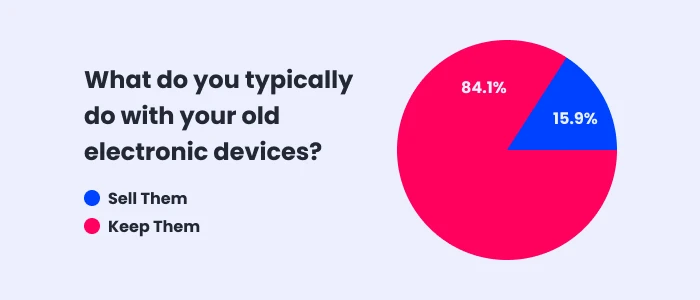

Some participants were aware of the impact of electronic waste but many of them didn’t know of any nearby recycling centers or repair shops. This suggests that participant’s ability to access proper repair and disposal facilities might be reduced, leading to the accumulation of more e-waste. Most participants replace their smartphones frequently, which suggests that technological advancements are making old electronic devices obsolete, leading to more frequent replacements. Most participants displayed a tendency to keep their old electronic devices, even though many of them were interested in selling them. This suggests that having an easily accessible method of selling used electronics might appeal to the participants. It is important to note that these findings cannot be generalized due to the small population size of my survey.
Understanding the Challenge
From the information obtained, we can raise two potential fundamental reasons for the issue of electronic waste:
- First, technological advancements are increasing the production of electronic products, which contain a complex set of hazardous materials [2], in addition to shortening their lifespan [10]. This leads to more frequent replacements and disposals, causing negative environmental impacts.
- Second, the lack of consumer awareness toward the importance of reuse, repair, and recycling. A 2020 Eurobarometer survey found that 77% of EU consumers prefer repairing their electronic products instead of getting new ones but end up having to replace or discard them due to repair costs and lack of services [6].
- First, technological advancements are increasing the production of electronic products, which contain a complex set of hazardous materials [2], in addition to shortening their lifespan [10]. This leads to more frequent replacements and disposals, causing negative environmental impacts.
- Second, the lack of consumer awareness toward the importance of reuse, repair, and recycling. A 2020 Eurobarometer survey found that 77% of EU consumers prefer repairing their electronic products instead of getting new ones but end up having to replace or discard them due to repair costs and lack of services [6].
Ideating a Solution
Many consumers do not immediately discard their old electronic products as they can retain value [1]. The survey findings suggest that many people who tend to keep their used electronic devices are interested in selling them but may not do so due to the lack of convenient services. According to Cui and Roven, an electronic device that is no longer useful to its owner can still be useful to others, where it can be resold or donated without requiring any further modification. They state that reusing electronic products has first-priority when it comes to e-waste management since their lifespan is extended to a secondary market, resulting in less waste [2].
In 2020, the European Commission presented a new circular economy plan where reducing e-waste was one of its priorities, outlining goals such as improving reusability and the right for repair [5]. The latter is considered a key step, as throwing away electronic products that could be repaired leads to 35 million tons of waste annually in the EU [6]. In addition, the survey findings suggest that despite many people being aware of the environmental impacts of e-waste, a disproportionate number do not know of any nearby recycling centers.
This offers the potential for a solution addressing these key issues, in the form of a web platform dedicated to used electronics. It would allow people to purchase, sell and rent used electronics, promoting reuse. In addition, it would offer an interactive map displaying nearby repair shops and recycling centers. At its core, this solution focuses on promoting reuse, repair, and recycling, to contribute toward a circular economy and decrease e-waste generation.
A digital solution would allow us to reach a larger audience regardless of location, as well as having a larger selection of products and reduced operating costs with it being a customer-to-customer (C2C) platform.
Designing the Brand
The logo design of Circulate highlights three key elements: circulation, people, and products. The typeface “Poppins” portrays a modern clean look, and the primary color blue displays trust and confidence.
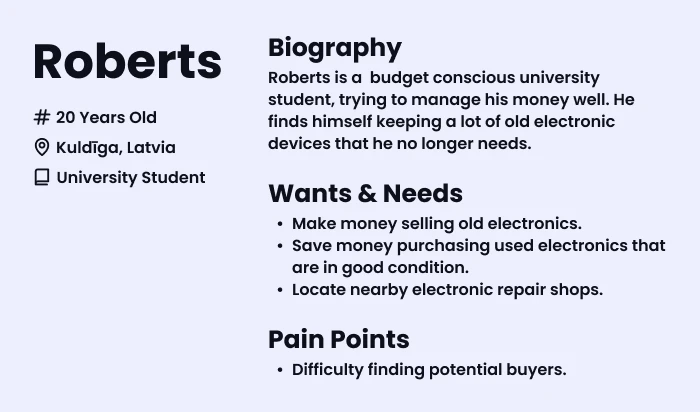
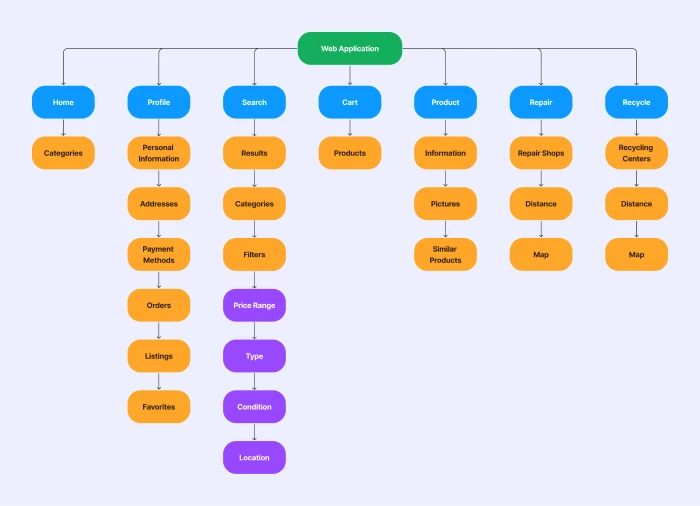
Prototyping the Solution
The platform has two primary functionalities:
- Selling, buying, and renting used electronics.
- Locating nearby repair shops and recycling centers.
- Selling, buying, and renting used electronics.
- Locating nearby repair shops and recycling centers.
To better organize the content on the platform, I mapped the following information architecture diagram:

The header of the website contains a search bar that allows users to quickly find a product, navigation icons which leads to repair shops, recycling centers, cart, and profile, as well as the primary call-to-action for listing a product for sale.
The home page contains a hero section describing the platform, and encouraging users to create an account to list a product for sale, or explore products through two call-to-action buttons. This is followed by a categories section that users can use to quickly browse certain products.
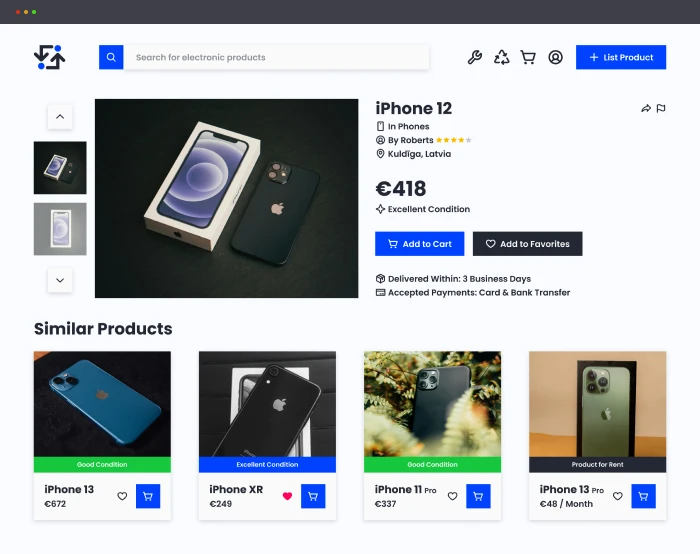
When users make a search query, they are redirected to a results page containing products cards and search filters. Each card provides the product name, price, and condition at a glance.
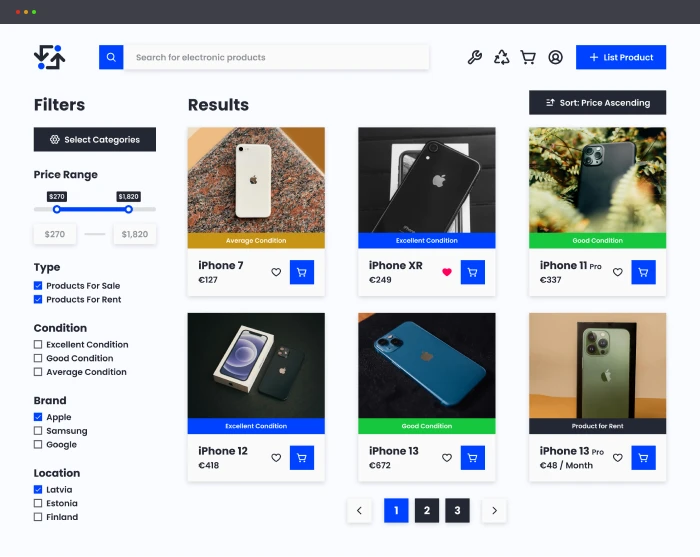
The item page provides more information and pictures about the product, and allows users to add it to cart or favorites to view at a later time. This page also shows similar products that the user might be interested in.
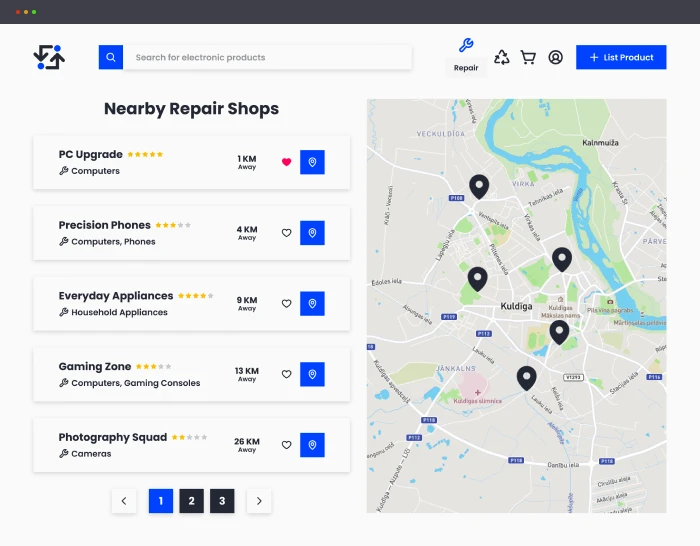
The repair page allows users to easily locate nearby repair shops and figure out what kind of electronic products they repair. Similarly, the recycle page allows users to locate recyling centers and figure out what kind of materials they take.
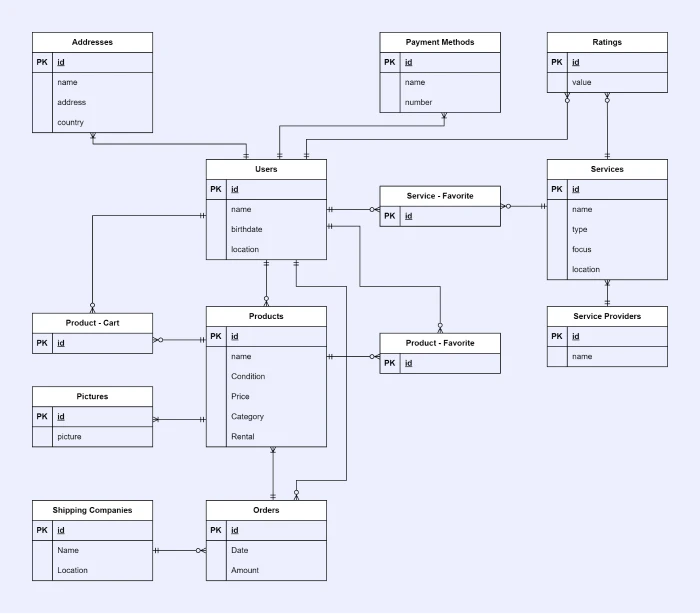
Thinking about the database design of the web application, I mapped the following entity relationship diagram, visualizing the relationship between different objects in the system.
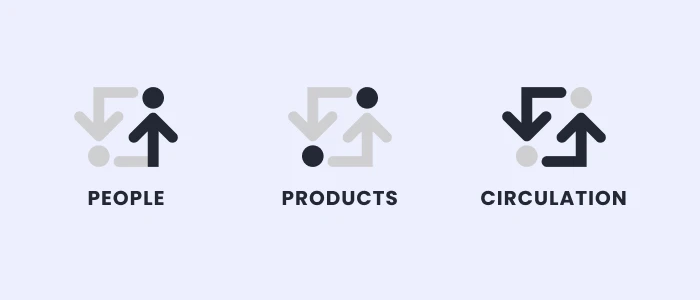
References
1. Babu, B. R., Parande, A. K., & Basha, C. A. (2007). Electrical and electronic waste: a global environmental problem. Waste Management & Research, 25(4), 307-318.
2. Cui, J., & Roven, H. J. (2011, January). Electronic waste. In Waste (pp. 281-296). Academic Press.
3. Directive, E. C. (2008). Directive 2008/98/EC of the European Parliament and of the Council of 19 November 2008 on waste and repealing certain Directives. Official Journal of the European Union L, 312, 3.
4. Directive, E. C. (2012). Directive 2012/19/EU of the European Parliament and of the Council of 4 July 2012 on waste electrical and electronic equipment, WEEE. Official Journal of the European Union L, 197, 43.
5. European Parliament (2020, December 23). E-waste in the EU: facts and figures (infographic).
6. European Parliament (2022, April 4). Why is the EU's right to repair legislation important?.
7. Eurostat (2023, October 24). Waste Statistics - Electrical and Electronic Equipment. European Commission.
8. Fritz, M., & Baumgartner, R. J. (2013). Reporting and exchange of social sustainability data along the supply chain of the electronics industry: Status quo, influencing factors and proposition of a framework.
9. Gabrys, J. (2013). Digital rubbish: A natural history of electronics. University of Michigan Press.
10. Kiddee, P., Naidu, R., & Wong, M. H. (2013). Electronic waste management approaches: An overview. Waste management, 33(5), 1237-1250.
11. Tanskanen, P. (2013). Management and recycling of electronic waste. Acta materialia, 61(3), 1001-1011.
12. Teller, M. (2006). Recycling of electronic waste material. In Sustainable Metals Management: Securing our Future-Steps Towards a Closed Loop Economy (pp. 565-571). Dordrecht: Springer Netherlands.
2. Cui, J., & Roven, H. J. (2011, January). Electronic waste. In Waste (pp. 281-296). Academic Press.
3. Directive, E. C. (2008). Directive 2008/98/EC of the European Parliament and of the Council of 19 November 2008 on waste and repealing certain Directives. Official Journal of the European Union L, 312, 3.
4. Directive, E. C. (2012). Directive 2012/19/EU of the European Parliament and of the Council of 4 July 2012 on waste electrical and electronic equipment, WEEE. Official Journal of the European Union L, 197, 43.
5. European Parliament (2020, December 23). E-waste in the EU: facts and figures (infographic).
6. European Parliament (2022, April 4). Why is the EU's right to repair legislation important?.
7. Eurostat (2023, October 24). Waste Statistics - Electrical and Electronic Equipment. European Commission.
8. Fritz, M., & Baumgartner, R. J. (2013). Reporting and exchange of social sustainability data along the supply chain of the electronics industry: Status quo, influencing factors and proposition of a framework.
9. Gabrys, J. (2013). Digital rubbish: A natural history of electronics. University of Michigan Press.
10. Kiddee, P., Naidu, R., & Wong, M. H. (2013). Electronic waste management approaches: An overview. Waste management, 33(5), 1237-1250.
11. Tanskanen, P. (2013). Management and recycling of electronic waste. Acta materialia, 61(3), 1001-1011.
12. Teller, M. (2006). Recycling of electronic waste material. In Sustainable Metals Management: Securing our Future-Steps Towards a Closed Loop Economy (pp. 565-571). Dordrecht: Springer Netherlands.